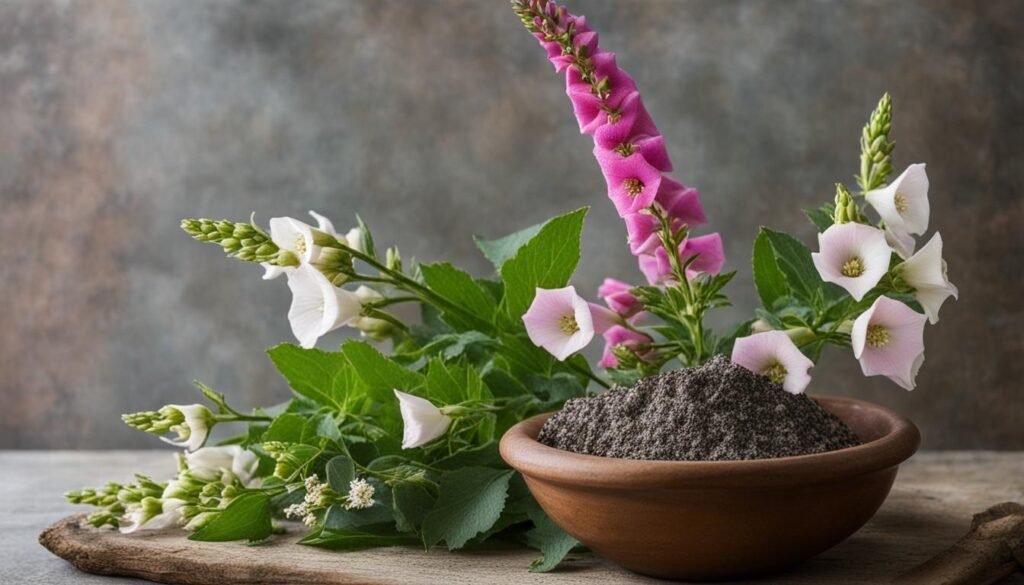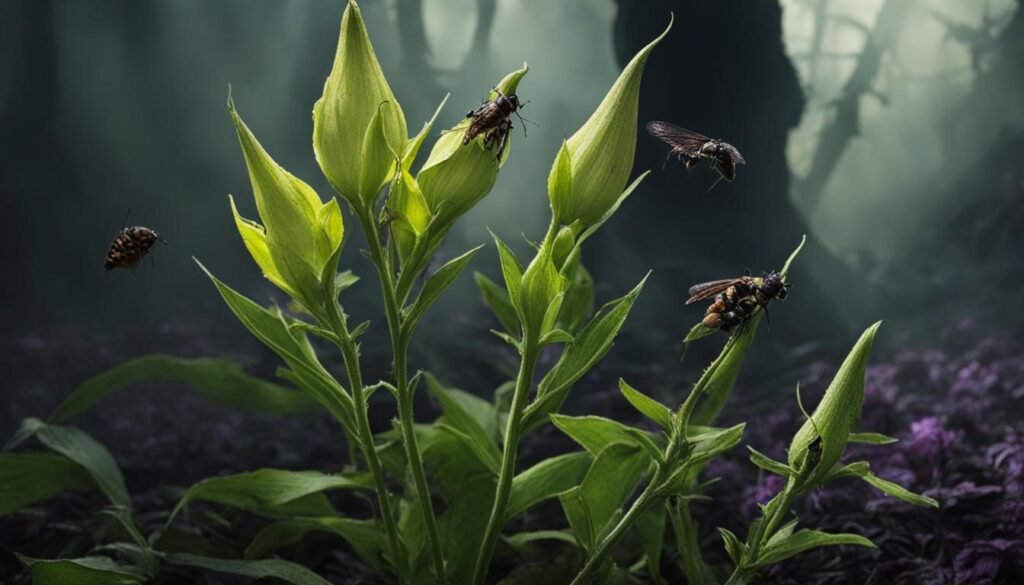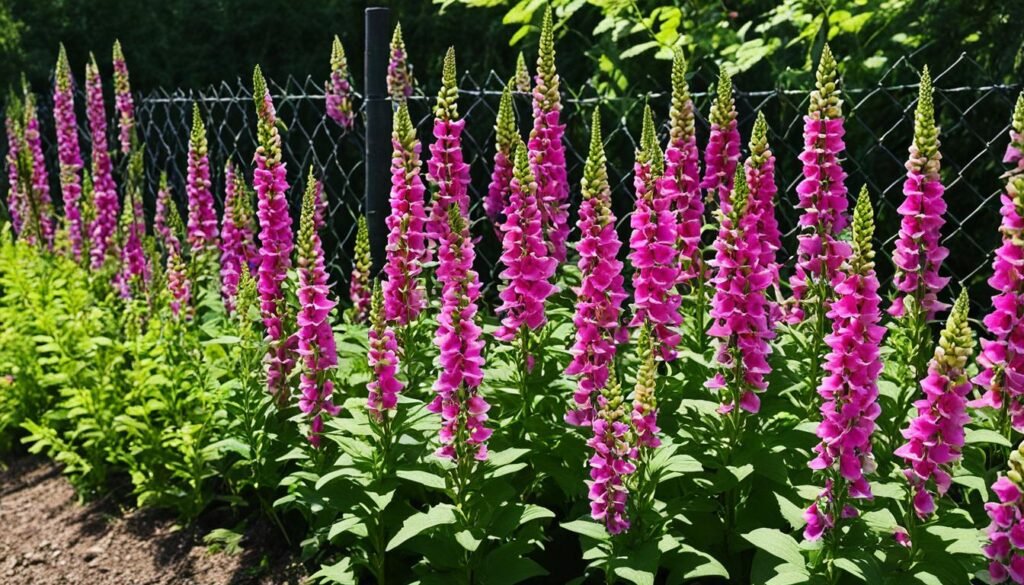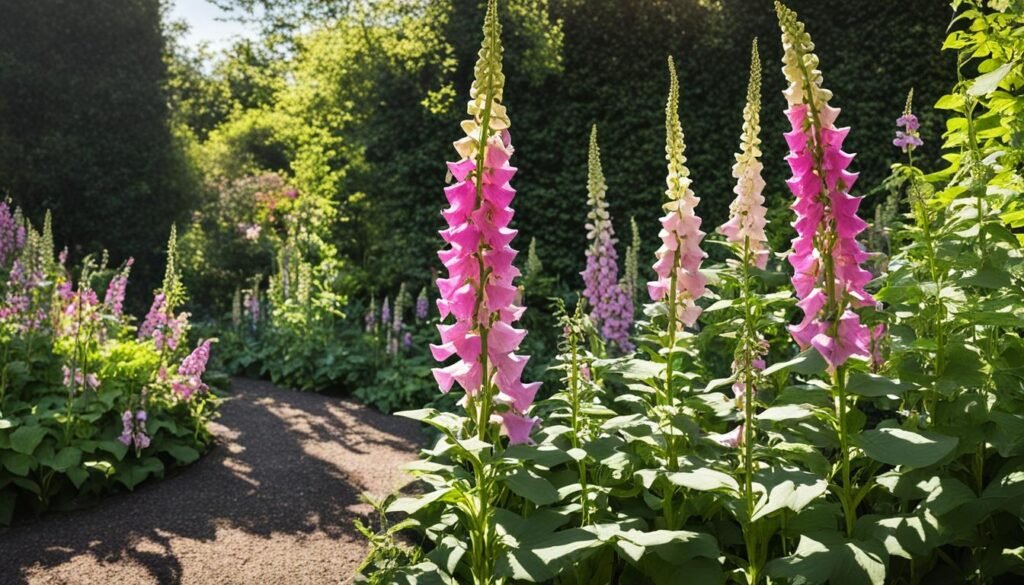As a lover of nature and its hidden tales, I am always fascinated by the folklore surrounding different plants. Recently, my curiosity has been piqued by the captivating legends and traditions associated with a particular flower – the foxglove. This humble yet enchanting flower, also known as digitalis, carries a rich tapestry of stories and beliefs that have been passed down through generations. Join me as we explore the captivating world of foxglove folklore.
Key Takeaways:
- Foxglove, also known as digitalis, has a rich folklore and history that dates back centuries.
- The association between foxglove and fairies gave rise to its nickname, “fairy’s glove.”
- Legends connect foxgloves to magic, protection against witchcraft, and even the entry of the Devil.
- Foxglove has been used medicinally throughout history, and its compounds are still used in modern heart medications.
- The striking beauty of foxgloves continues to inspire literature, art, and contemporary culture.
Foxgloves and Fairy Folklore
In folklore, fairies were believed to have magical powers and the ability to enchant or curse people. Foxglove, with its beautiful bell-shaped flowers, was connected to the fairy folk. The plant was believed to be a reminder of the fairies’ power and was called “folks’ glove” or “fairy’s glove” in old English. It is said that fairies could be communicated with through the use of dew collected from foxgloves. Foxgloves were often associated with protection against witchcraft and were used to ward off evil spirits. However, picking a foxglove was seen as unlucky because it was believed to be one of the fairies’ favorite plants. The association between foxglove and fairies also had darker aspects, with legends in Scotland and North England linking the presence of foxglove flowers to the entry of the Devil into a house.

Legends of Foxgloves and Fairies
According to one legend, the foxglove flowers were actually fairy bells that would ring to warn the fairies of approaching danger or intruders. The sound of the bells was believed to scare away evil spirits and protect the fairies’ secret domain.
The delicate beauty of the foxglove flowers, with their purple and pink hues, added to the allure of the fairy folk. In many tales, it was said that the colors of the flowers were left behind by fairies who had touched them, enhancing their magical properties. The unique shape of the foxglove flowers, resembling gloves or thimbles, only deepened the connection to the fairy realm.
| Symbolism | Meaning |
|---|---|
| Protection | Foxgloves were believed to protect against witchcraft and evil spirits. |
| Enchantment | The beauty of foxglove flowers was associated with enchantment and magic. |
| Warning | Legend had it that the foxglove bells would ring to warn fairies of danger. |
Medicinal Uses of Foxglove
Foxglove has been used for centuries for its medicinal properties. The plant’s extracts have been employed in various forms to treat a range of ailments. From skin issues to flea infestations and even common colds, foxglove has been a staple in traditional medicine.
However, it’s important to note that foxglove contains potent cardiac glycosides, which can be toxic if consumed in large quantities. This toxicity has led to caution in the use of foxglove as a medicinal herb. The plant’s powerful compounds must be carefully measured and administered under the guidance of a medical professional.
In modern medicine, the compound digoxin, derived from foxglove, is used for the treatment of heart conditions. Digoxin helps regulate and strengthen the contractions of the heart, making it an invaluable medication for individuals with cardiac issues.
Despite the potential dangers associated with foxglove, its rich folklore and long-standing tradition in herbal medicine have inspired its usage in modern medical practices. This demonstrates the profound impact that folklore and traditional remedies have had on the development of contemporary medicine.

| Traditional Uses | Modern Medical Applications |
|---|---|
| To treat skin issues, such as rashes and burns | Not commonly used externally |
| To repel fleas and treat flea bites | Not applicable |
| To relieve symptoms of the common cold | Not applicable |
| As a general tonic for overall well-being | Not applicable |
| To regulate and strengthen heart contractions | Digoxin for the treatment of heart conditions |
Foxglove Myths and Legends
Foxglove is shrouded in a tapestry of myths and legends that span across different cultures. In Scottish mythology, the tale of Tam Lin tells of a man captured by the Queen of Fairies, later rescued by a courageous maiden. The enchanting presence of foxglove in this legend reflects its association with the mystical realm of fairies and their magical powers.
In Roman mythology, foxglove was believed to have played a role in the tale of Flora, the goddess of flowers, teaching Hera how to conceive without a man. This intriguing connection reinforces the ethereal nature attributed to the plant and its significance in ancient folklore.
Throughout history, foxglove has been associated with death and healing, earning it eerie names like “Dead Man’s Thimbles” and “Dead Men’s Bells.” These haunting names serve as a testament to the enigmatic qualities of foxglove and its profound symbolism in various cultures.
As I delve deeper into the world of foxglove folklore, I uncover the captivating stories and legends that have shaped our understanding of this enchanting plant.
The Dark Side of Foxglove
While foxglove has medicinal properties, it should be handled with caution. The plant contains compounds that can be toxic when consumed in large quantities. Overdosing on foxglove can lead to symptoms such as severe nausea, vomiting, and even death, as the plant slows down the heart rate. It is essential to be aware of the potential dangers associated with foxglove and to use it responsibly.
Foxglove, also known as digitalis purpurea, is a stunning flowering plant that has been used for centuries in medicine and folklore. It contains cardiac glycosides, a class of compounds that affect the heart and can be toxic if ingested in high doses. The leaves, flowers, and seeds of foxglove all contain these potent compounds, which give the plant its medicinal qualities but can also cause harm.
When used in the correct dosage under medical supervision, foxglove can be beneficial for certain heart conditions. The compound digoxin, derived from foxglove, is commonly used to treat congestive heart failure and atrial fibrillation. However, the narrow therapeutic index of digoxin means that even a slight overdose can have severe consequences.
“Foxgloves contain cardiac glycosides, which can be toxic if consumed in large quantities.”
The toxic effects of foxglove can range from gastrointestinal symptoms such as nausea, vomiting, and diarrhea to more serious complications, including irregular heart rhythms, heart block, and even heart failure. Individuals who accidentally ingest or intentionally misuse foxglove should seek immediate medical attention to prevent further harm.
It is crucial to note that the toxic effects of foxglove can also extend to pets and other animals. Keep foxglove plants out of reach to prevent accidental ingestion by curious pets or wildlife.
Here are some key points to remember about the toxic effects of foxglove:
- Foxglove contains compounds that can be toxic if consumed in large quantities.
- Overdosing on foxglove can lead to severe symptoms such as nausea, vomiting, and irregular heart rhythms.
- Seek immediate medical attention if you suspect foxglove poisoning.
- Keep foxglove plants out of reach of children, pets, and wildlife to prevent accidental ingestion.
Toxic effects can also occur through skin contact with foxglove plants. It is advisable to wear gloves when handling these plants or when gardening in areas where foxgloves are present.
Despite the potential dangers, foxgloves continue to be valued and utilized in medicine. However, it is important to recognize their toxic nature and exercise caution when using or coming into contact with these beautiful yet potent plants.
Remember: beauty can sometimes be deceiving, and it’s crucial to respect the power of nature’s potent creations.

Foxgloves in Literature and Art
Foxgloves have a magical allure that has captivated artists and writers throughout history. They have inspired numerous works of literature and art, often symbolizing beauty, enchantment, and danger. Whether portrayed in poetry, novels, or paintings, foxgloves evoke a sense of mystery and wonder.
The unique appearance of foxgloves, with their tall spires of bell-shaped flowers, has made them a popular subject in visual arts. Artists have skillfully captured the delicate elegance and vibrant colors of these blooms, showcasing their ethereal charm. Foxgloves often appear in lush garden scenes, adding depth and visual interest to paintings.
In literature, foxgloves have been used to convey various themes and evoke different emotions. They serve as symbols of both fragile beauty and potential danger. Writers often employ foxgloves to create an atmosphere of enchantment or to foreshadow the presence of something mysterious or otherworldly.
“The foxgloves swayed gently in the breeze, their purple petals whispering secrets of the hidden realms.”
Foxgloves have also been used to metaphorically illustrate the complexities of human nature. Their dual nature, both enchanting and toxic, has been a source of inspiration for authors exploring themes of duality, deception, and transformation.
The Symbolism of Foxgloves
The symbolism associated with foxgloves adds another layer of depth to their presence in literature and art. These flowers have often represented beauty, grace, and charm. However, they can also convey a sense of danger or warning, as their poisonous properties are well-known.
In certain works, foxgloves have been used as allegorical devices, embodying the juxtaposition of life and death, love and betrayal, or good and evil. Their presence in a scene can help convey complex emotions, leaving a lasting impression on the reader or viewer.
Overall, foxgloves in literature and art serve as powerful symbols that engage the imagination, provoke thought, and evoke a range of emotions. They continue to inspire both creators and audiences, reminding us of the enduring allure of these enchanting blooms.

Symbolism and Inspirations
Foxgloves are not only admired for their visual appeal but also for their symbolic significance. The graceful form of the flowers and their connection to folklore and mythology make them a source of inspiration in contemporary literature, art, and design. Authors and artists often incorporate foxgloves into their works, using them as metaphors for beauty, enchantment, and the delicate balance between life and death.
Modern Uses of Foxglove in Contemporary Culture
| Field | Uses |
|---|---|
| Medicine | Treatment of heart conditions with digoxin |
| Gardening | Ornamental plant in gardens and floral arrangements |
| Literature and Art | Inspiration for symbolism and artistic creations |
While the belief in fairies and their association with foxgloves may have diminished, the plant’s significance in contemporary culture remains steadfast. Its presence in medicine, gardens, and artistic expressions testifies to the enduring allure and relevance of foxgloves in today’s world.
Foxgloves in Fairy-themed Crafts and Decorations
Foxgloves have become a beloved symbol in the world of fairy-themed crafts and decorations. Their enchanting nature and delicate beauty make them a perfect fit for creating magical fairy-inspired artwork and designs.
One popular way to incorporate foxgloves into fairy-themed crafts is by creating miniature fairy houses with foxglove-inspired designs. These tiny dwellings are often made from natural materials such as twigs, leaves, and moss, and are adorned with small foxglove flowers to add a touch of whimsy and charm.
Another creative way to incorporate foxgloves into fairy-themed crafts is through intricate artwork. Artists may use foxgloves as a central element in their paintings or create delicate paper cutouts of foxglove flowers to be used in collages or mixed media pieces. These artworks capture the ethereal and magical qualities associated with both foxgloves and fairies.
“I find great joy in creating fairy-themed crafts and decorations using foxgloves. There’s something truly enchanting about the combination of these delicate flowers and the magic of fairies.” – Sarah, Fairy Craft Enthusiast
The use of foxgloves in fairy-themed crafts and decorations allows individuals to bring a sense of wonder and whimsy into their homes and creative spaces. Whether it’s a fairy house tucked away in a garden or a beautiful foxglove-inspired artwork adorning the walls, these crafts help to evoke a sense of magic and enchantment.
If you’re looking to bring a touch of fairy magic into your home or explore your creative side, consider incorporating foxgloves into your next craft project. Let your imagination soar as you create your own little world of fairies and magical blooms.

Fairy-themed Craft Ideas with Foxgloves:
- Create a miniature fairy house using natural materials and decorate it with foxglove flowers.
- Paint a canvas with a beautiful foxglove-inspired landscape and add fairy elements.
- Make intricate paper cutouts of foxglove flowers to be used in collages or mixed media artwork.
- Design a fairy-themed wreath using dried foxglove flowers and other natural elements.
- Craft delicate fairy dolls or figurines with foxglove petals for their dresses.
Foxgloves in Gardens and Landscaping
Foxgloves are a delightful addition to any garden or landscape, bringing beauty and charm to outdoor spaces. Their tall spires of bell-shaped flowers create vertical interest, adding a touch of elegance to flower beds, borders, and even containers. With their wide range of colors, including shades of pink, purple, and white, foxgloves can complement various garden styles, from enchanting cottage gardens to formal landscapes.
When planning your garden or landscaping project, consider incorporating foxgloves for their visual appeal and ecological benefits. The striking blooms of these plants not only attract human admirers but also invite important pollinators, such as bees and butterflies, to your outdoor space. By including foxgloves in your garden, you contribute to the preservation of these vital pollinators and support a healthy ecosystem.
Here are some ideas for incorporating foxgloves into your garden or landscape:
- Flower beds: Plant foxgloves in flower beds as stunning focal points or to add verticality and depth to your design. Consider creating a dramatic effect by combining them with low-growing flowers or groundcovers.
- Back borders: Use foxgloves to create a backdrop for your garden by planting them along the back border of your flower beds. The tall spikes of flowers will add height and beauty, framing the rest of your plants.
- Cottage gardens: Foxgloves are a natural fit for charming cottage gardens. Their old-world charm and romantic blooms complement the informal and relaxed style of these gardens.
- Woodland gardens: Foxgloves also thrive in woodland or shaded areas of your landscape, mimicking their natural habitat. Their delicate blooms add a touch of magic and enchantment to these serene settings.
- Containers: Don’t have a garden? No problem! Foxgloves can thrive in containers, allowing you to enjoy their beauty on balconies, patios, or even windowsills.
Remember to select a location for your foxgloves that provides partial shade or filtered sunlight, as they prefer these conditions. Additionally, make sure to provide fertile, well-drained soil to promote healthy growth and blooming.
Incorporating foxgloves into your garden or landscape not only adds visual interest but also connects you to the rich folklore and natural beauty associated with these enchanting plants.

Foxgloves as Symbolic Flowers
Foxgloves hold a special place as symbolic flowers, representing various meanings and captivating the imagination. Let’s explore the symbolic significance of these enchanting plants.
Perseverance: The tall and elegant spires of foxgloves can symbolize perseverance, reminding us to stay determined and resilient in the face of challenges.
Charm: With their bell-shaped flowers and vibrant colors, foxgloves exude charm and charisma. They can symbolize captivating beauty and have the power to enchant those who come across them.
Fascination: Foxgloves possess an air of mystery and intrigue, making them fascinating symbols. Their connection to folklore and mythology adds to their allure, inviting us to delve deeper into their symbolism and stories.
Quotes:
“Foxgloves, with their graceful appearance and delicate flowers, embody a sense of mystery and fascination.”
“The symbolism of foxgloves extends beyond their physical beauty, representing qualities like perseverance and charm.”
The Symbolic Meanings of Foxgloves:
| Symbolic Meaning | Description |
|---|---|
| Perseverance | Represents the ability to endure and stay strong in challenging situations. |
| Charm | Symbolizes captivating beauty and the power to enchant others. |
| Fascination | Evokes a sense of mystery and intrigue, drawing people into their captivating world. |
To illustrate the symbolic beauty of foxgloves, take a moment to admire this stunning image:

Foxglove Conservation and Protection
As foxgloves are vulnerable to habitat loss and overharvesting, efforts are being made to conserve and protect these plants. Conservation organizations and gardening enthusiasts are promoting the cultivation of foxgloves in gardens and the preservation of their natural habitats. The conservation of foxgloves is vital to ensure that their folklore and beauty continue to inspire future generations.
In order to safeguard the foxglove population, conservation initiatives are focused on:
- Creating awareness about the importance of foxgloves and their ecological role.
- Implementing measures to protect foxgloves from habitat destruction and fragmentation.
- Encouraging the cultivation of foxgloves in home gardens and public spaces.
- Promoting responsible harvesting practices to prevent overexploitation of wild populations.

The conservation efforts aim to ensure that future generations can appreciate and benefit from the natural beauty and cultural significance of foxgloves. By protecting these enchanting plants, we preserve a piece of folklore and contribute to the overall biodiversity of our ecosystems.
Foxgloves in Herbal Medicine
In herbal medicine, foxgloves have been utilized for their various medicinal properties. The plant, known for its striking bell-shaped flowers, has long been associated with traditional remedies and natural healing. However, it is crucial to approach the use of foxgloves in herbal medicine with caution due to its potentially toxic nature.
Historically, foxgloves were believed to possess healing properties and were commonly used in the treatment of sores, ulcers, and wounds. The plant’s powerful compounds, called cardiac glycosides, were thought to aid in reducing inflammation and promoting the regeneration of damaged tissues.
Although foxgloves have been used in traditional herbal medicine, it is imperative to seek expert guidance and exercise extreme caution when considering their use. The toxicity of foxgloves can have severe consequences if ingested in large quantities or without proper knowledge.
The cardiac glycosides found in foxgloves can have potent effects on the cardiovascular system, making accurate dosage and administration critical. These compounds can affect heart rate and rhythm, and therefore, medical supervision is essential to ensure safe usage.
Despite its potential dangers, the rich history of using foxgloves in herbal medicine highlights the plant’s significance in traditional healing practices. As with any herbal remedy, it is advisable to consult a qualified herbalist or healthcare professional before considering the use of foxgloves for medicinal purposes.
| Benefits of Foxgloves in Herbal Medicine | Precautions and Considerations |
|---|---|
|
|
Expert Insight: The Importance of Professional Guidance
When considering the use of foxgloves in herbal medicine, expert guidance is essential. Qualified herbalists and healthcare professionals can provide invaluable knowledge and ensure safe and effective usage. They can assess individual medical histories, recommend appropriate dosages, and monitor any potential side effects or interactions.

This image showcases the delicate elegance of foxgloves, inviting viewers into a world where nature and imagination intertwine.
Contemporary literature and art continue to celebrate the allure of foxgloves, showcasing their timeless appeal and connection to enchantment and imagination.
Conclusion
Foxglove folklore weaves together a captivating tapestry of mythology, superstition, and natural beauty. This enchanting plant’s association with fairies, medicinal properties, and symbolic meanings has fascinated cultures throughout history. Whether regarded as a perilous plant or a source of healing, foxgloves occupy a significant place in folklore and continue to ignite the imagination in modern society. The intricate stories surrounding foxglove folklore serve as a powerful reminder of the enduring allure of storytelling and the deep interconnection between nature and human culture.
From the mythical realm of fairies, where foxglove blooms were believed to hold magical powers, to the realm of medicine, where foxglove-derived compounds treat heart conditions, this plant has left an indelible mark on human culture. The resplendent foxglove, with its bell-shaped flowers and towering spires, symbolizes both danger and fascination. Its presence in literature, art, gardens, and festivals exemplifies its timeless appeal and enduring significance.
The rich history of foxglove folklore showcases humanity’s enduring fascination with the natural world. As we delve into the lore of foxgloves, we encounter a delicate balance between myth and reality, caution and curiosity. Foxglove folklore is a testament to our innate desire to ascribe meaning, wonder, and mystery to the world around us, grounding us in the interconnectedness of nature, myth, and human experience.
FAQ
What is the meaning of foxglove?
Foxglove, also known as digitalis, gets its name from the old English term “folksglove,” meaning “fairy’s glove.” It is believed to have derived from its association with folklore and mythical creatures.
What are the medicinal uses of foxglove?
Foxglove has a long history of medicinal use. It contains cardiac glycosides, which are used to treat heart conditions. However, the plant should be handled with caution, as it can be toxic if ingested in large quantities.
What are some myths and legends associated with foxglove?
Foxglove is linked to various myths and legends. In Scottish mythology, it is mentioned in the tale of Tam Lin. It is also associated with Roman mythology, where it played a role in the story of Flora, the goddess of flowers.
Are foxgloves toxic?
Yes, foxgloves contain compounds that can be toxic if consumed in large quantities. Overdosing on foxglove can lead to severe symptoms and even death, as it affects the heart rate.
How are foxgloves depicted in literature and art?
Foxgloves are often depicted as enchanting and otherworldly in literature and art. They symbolize beauty, danger, and magic, capturing the imagination of artists throughout history.
How are foxgloves used in contemporary culture?
Foxgloves continue to be used in modern medicine for the treatment of heart conditions. They are also popular in gardens, floral arrangements, and fairy-themed crafts and decorations.
What is the symbolic meaning of foxgloves?
Foxgloves symbolize perseverance, charm, and fascination. Their graceful appearance and connections to folklore and mythology give them a sense of mystery and intrigue.
Are there any festivals or events dedicated to foxgloves?
Yes, there are foxglove festivals and events organized to celebrate the plant’s beauty and cultural significance. These events include flower displays, gardening workshops, and educational sessions on foxglove history and uses.
How are foxgloves conserved and protected?
Due to habitat loss and overharvesting, efforts are being made to conserve and protect foxgloves. Conservation organizations and gardeners promote their cultivation in gardens and the preservation of their natural habitats.
What are the uses of foxgloves in herbal medicine?
Foxgloves have been traditionally used in herbal medicine for treating sores, ulcers, and wounds. However, their toxic nature requires careful consideration and expert guidance when using them in herbal remedies.
How are foxgloves represented in traditional folk remedies?
Foxgloves have been part of traditional folk remedies, treating ailments such as colds, heart conditions, and the King’s Evil. These remedies were passed down through generations, relying on the plant’s purported healing properties.
How do foxgloves inspire contemporary literature and art?
Foxgloves’ mystical and symbolic qualities make them a popular subject in contemporary literature and art. They evoke wonder and magic, adding a sense of enchantment to creative works.




